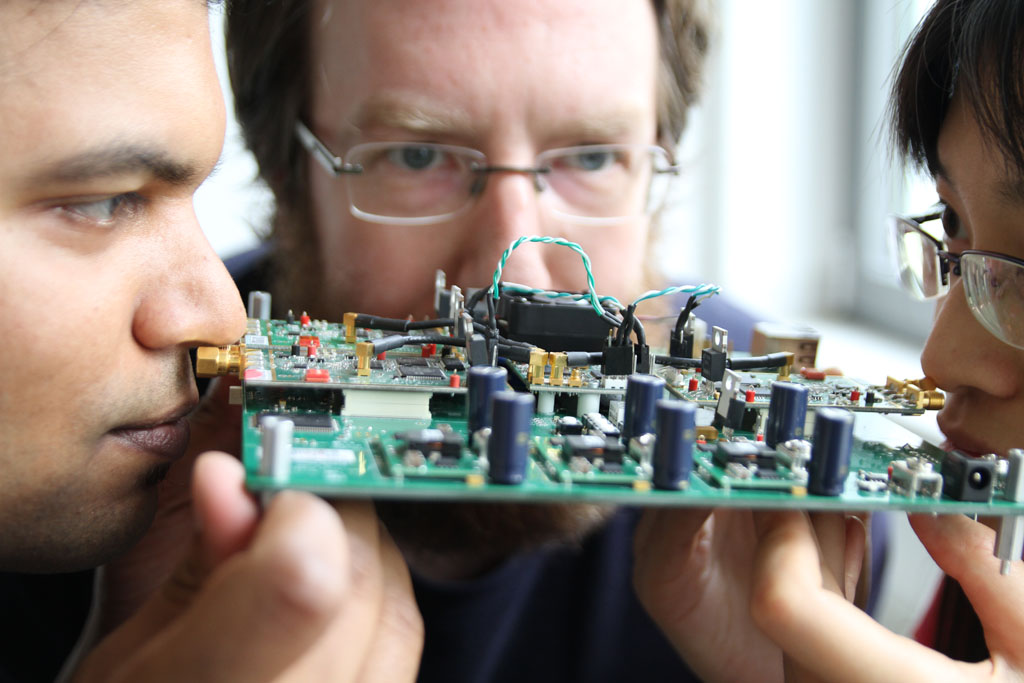Institute for Networked Systems at RWTH Aachen University, Germany: Cognitive Wireless Networking Research with WARPs
Our group has been working on cognitive radio and cognitive wireless networking research for close to a decade now, tackling problems ranging from physical layer issues such as spectrum sensing all the way to network-wide resource management solutions. While analytical models and simulations are still needed, prototyping of the developed solutions in actual network testbeds has become an indispensible part of the work. After gathering experiences with a number of software defined radio platforms, we have adopted WARPs as one of our core development environments, used especially for our most demanding applications and a number of our technology transfer projects have also relied on WARP-board based designs.
We have already completed a number of research projects using WARPs, with many more ongoing. For example, we have developed and prototyped new types of Medium Access Control (MAC) protocols for cognitive radios, experimented with various distributed and centralized resource management algorithms for cognitive wireless networks, and studied various spectrum sensing problems such as waveform classification using machine learning techniques. Our ongoing work includes, for example, development of solutions for resource management and interference minimization in femtocells, and WARPs are again being used as the main prototyping platform. In addition to usual journal and conference publications, we have been actively making live demonstrations of our work with WARPs in top venues, such as ACM MOBICOM, IEEE INFOCOM and IEEE DySPAN. Currently we are also working on porting and finalizing our Cognitive Resource Manager framework into WARPs, something that we are also planning to release later to the community.
As a more detailed example of recent work, we have designed component based MAC development framework allowing fast prototyping of dynamic MAC solutions with runtime reconfigurability. As a part of this framework, we have implemented a MAC component library with flexible set of APIs and a scheme that allows binding of the different components together at the run time. The component implementation is partitioned in hardware on the FPGA as well as on the software in PowerPC. This framework contains custom modifications of the hardware, e.g., interrupt controller support for performance improvement. A particular MAC realization using the framework fully utilizes the flexible PHY/MAC features as well as the component virtualization and power management that we provide. This implementation has allowed us to develop, among others, a decentralized MAC protocol for Cognitive Wireless Networks that allows dynamic selection of a reliable channel for data communication in high interference environments. The protocol is specifically designed to suit deployments where a coordinating infrastructure does not exist.
In addition to research, we are actively using WARPs in our teaching work. Our applications range from demonstration of fundamental physical layer design concepts during courses on wireless networking fundamental to dedicated lab courses. We also let students using WARPs for their thesis and project work with us. The power and flexibility of WARPs enables students to get hands-on experience with issues such as MIMO communications that previously could only be taught from theoretical viewpoint or through simulations. This approach has generated a fundamental change to our teaching methodology and syllabus in some of our courses. Moreover, the early experience after a couple of years indicates strongly that the motivation and skill sets of the students have increased in significantly after adopting such a more hands-on approach.
Pictured: Few of the group members having a closer look at a WARP board. (From left: J. Ansari, J. Riihijärvi, and X. Zhang).
